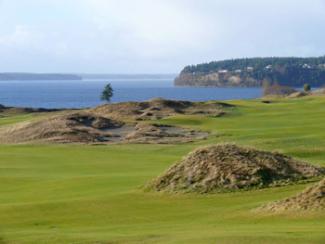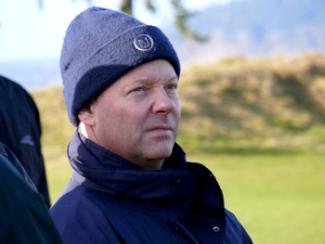Featured Golf News
Chambers Bay Still Firmly in Sights of USGA
The rumors had circulated around Chambers Bay for some time, rumors that the USGA would renege on its commitment to hold the 2015 U.S. Open on the fledgling course just west of Tacoma, Wash.

The Famed Lone Fir on the Par-3 15th Hole at Chambers Bay
There was any number of reasons for such hearsay. The course was losing money, the greens were not "Tour" quality, there was no clubhouse and there wasn't likely to be one. What there would be, critics insisted, was too much traffic and too little parking.
With more than two years to go before the first U.S. Open ever played in the Pacific Northwest, there is no lingering talk about moving the event.
The rebuilding of four greens is complete, USGA executive Danny Sink is on-site, the overall shape of the course is excellent, and USGA czar Mike Davis remains as committed and excited as ever to the notion of an U.S. Open Championship at Chambers Bay.
"The reports I have on Chambers Bay are very, very positive," Davis said recently. "I'm excited."
Davis has always been a fan of Chambers Bay, seeing the potential for an Open in the refurbished sand pit alongside Puget Sound before most did; even before he became executive director of the USGA.

Mike Davis, Executive Director of the USGA
He is fascinated by the possibility of playing the Open on what he calls "fine fescue" grasses, a first, he says, for the USGA. "There will be many players who have never played on fine fescue grasses, and that includes those who have played in the British Open. Those courses are so old that they have grasses of all types, and not just fine fescues."
Davis contends fescue allows the golf ball to roll free, or "beautifully," as he calls it. Even in wet conditions. The irony is that of most of the criticism of Chambers Bay by everyday players is that the greens were in poor condition. The complaints were valid.
Some of the problems came from a rush to hold the 2010 U.S. Amateur there just three years after the course opened. A fateful decision was made to hold off eradicating a moss growth on the greens for the sake of the Amateur.
At the time the moss problem was finally attacked, the greens didn't survive the treatment very well. They just weren't very healthy. At that point Pierce County, which owns the course, and KemperSports, which manages it, made a decision to hire Eric Johnson as director of agronomy and promote Josh Lewis to superintendent. Before coming to Chambers Bay, both had experience growing and maintaining fescue at Bandon Dunes, about 400 miles to the south on Oregon's Pacific Coast.
For the first time, greens seem to be holding their own against winter and increased play by locals. Because the Open is held in June and not August as was the Amateur, the fairways and greens won't be butterscotch brown and hard as pavement, but they should be appropriately firm and at the same time free of native grasses.
The Chambers Bay you see today is pretty much the one you'll see in 2015, except for areas of rough that will be basically uncut through spring of that year. Greens have been rebuilt on Nos. 1, 4, 7 and 13. The driving area on the par-4 fifth has been reduced with the expansion of waste areas on each side of the fairway.
And the 18th hole has been toughened with the expansion of a waste area right off the tee and a nasty eight-foot-deep pot-and-kettle bunker 100 yards short of the green.
The course has been lengthened on almost every hole with the expansion of tee areas, but even though the course could play at near 8,000 yards, it won't. The added tees will simply give Davis and the USGA daily set-up options depending mostly on weather conditions, and wind directions.

Robert Trent Jones Jr. (left) & Mike Davis
Viewing Chambers Bay
As far as Davis is concerned, the changes have not altered the original design of Robert Trent Jones Jr. and Bruce Charlton, but simply made the course "play the way the architects designed it."
At one point, Jones admitted his firm had pushed the envelope on some of the greens and, in some cases, pushed it too far. During the 2010 U.S. Amateur at Chambers Bay, of 90 balls that landed on the first green only eight stayed there. Many rolled more than 100 yards off the green.
The fourth, seventh and 13th greens were built into a steep hillside east of the course and simply wouldn't hold shots. They've all been softened to better reward a well-planned and played approach. The same is true with approach shots to the par-5 eighth hole, where the green surrounds were leveled.
Starting this spring, the first hole will be played primarily as a par-5, and the 13th as a par-4. For most of us, No. 1 was already a par-5.
Davis also added a new tee on the over-the-cliff par-3 ninth. The new tee is near the old practice area and will provide the option to play a rather level, 185-yard shot into the north side of the green. "We've never had a course as flexible as Chambers Bay for an Open," said Davis. "We will play the first hole as a par-5 on some days, and a par-4 on others.
"And the 18th will be both a par-4 and a par-5 as well. The new bunkering presents fascinating challenges for the tee shot, depending on which tees are used."
During the Amateur, Davis moved the tees more than 100 yards on the par-4 16th hole. At the 15th, the par-3 with the lone fir tree in the background, the hole can play from 145 to 245 yards.
Outside the ropes, there's still much work to be done. Parking seems to be the biggest problem, and not the lack of a clubhouse. Sink, the USGA's director for the tournament, said it was easier to erect a temporary clubhouse than it is to try and revamp an existing one. Most established clubhouses, he noted, are too small for the needs of a U.S. Open anyway.
The operation of the Open will move down the hill from the current clubhouse to the so-called Central Meadow just south of the 18th fairway. It is there that scores of buses will arrive, carrying spectators from various parking lots. It is there where tickets will be taken, stories will be written and golf shirts sold.
Corporate tents will be located on the old driving range.
At this year's Open in San Francisco, the USGA used the expansive parking lot at Candlestick Park to handle parking. There is no such site near Chambers Bay.
Sink said the first day he came to view Chambers Bay he couldn't see it because of the low-hanging weather. "We've never had a site like this," he said, "not one with the elevation changes here. It's amazing."
Sink said the topography that allows unprecedented viewing for spectators will also provide rigorous walks to get around the course. Davis said he envisions an Open where spectators are more likely to find a vantage point and stay there, more like they do at a British Open than a U.S. Open.
On fine fescue grasses, of course.
Blaine Newnham has covered golf for 50 years. He still cherishes the memory of following Ben Hogan for 18 holes during the first round of the 1966 U.S. Open at the Olympic Club in San Francisco. He worked then for the Oakland Tribune, where he covered the Oakland Raiders during the first three seasons of head coach John Madden. Blaine moved on to Eugene, Ore., in 1971 as sports editor and columnist, covering the 1972 Olympic Games in Munich. He covered five Olympics all together - Mexico City, Munich, Los Angeles, Seoul, and Athens - before retiring in early 2005 from the Seattle Times. He covered his first Masters in 1987 when Larry Mize chipped in to beat Greg Norman, and his last in 2005 when Tiger Woods chip dramatically teetered on the lip at No. 16 and rolled in. He saw Woods' four straight major wins in 2000 and 2001, and Payne Stewart's par putt to win the U.S. Open at Pinehurst. In 2005, Blaine received the Northwest Golf Media Association's Distinguished Service Award. He and his wife, Joanna, live in Indianola, Wash., where the Dungeness crabs outnumber the people.
Story Options
 |
Print this Story |
